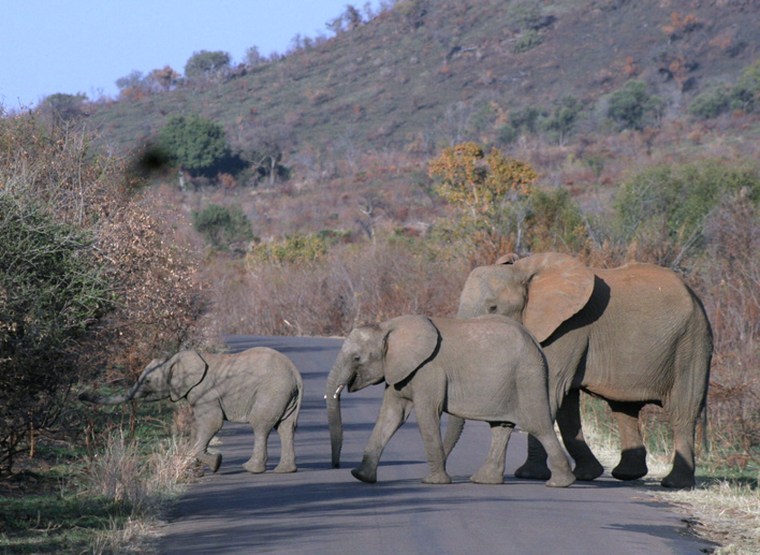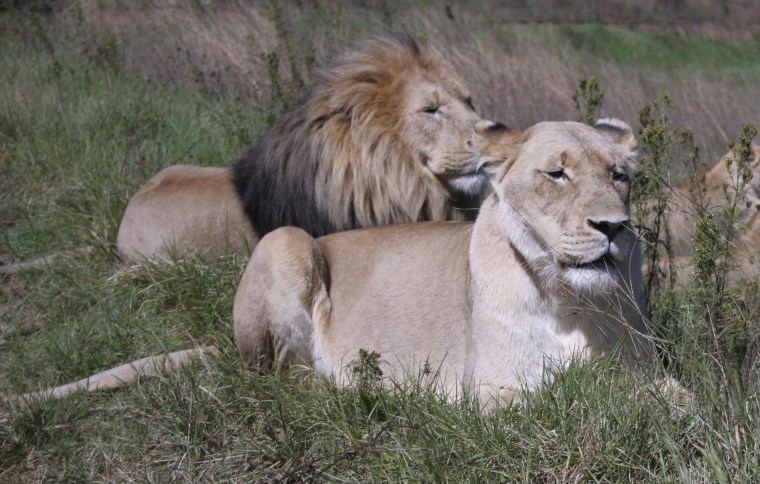Lions and cheetah, check. Buffalo, check. Rhino, hippo and leopard. check. Penguins, check. South Africa has them all.
The country has nearly 600 national parks and reserves — plenty of opportunity for the hordes of visitors coming for Africa's first World Cup to do something besides watching football.
South Africa's best known game reserve is Kruger National Park, near one of the World Cup host cities, Nelspruit, in the north. Kruger boasts the Big Five — buffalo, elephant, leopard, lion and rhino. The reserve is the size of the state of Massachusetts, but it might still seem crowded with tourists during the June-July World Cup. Still, there are off-the-beaten track options that are just as exciting and probably more accessible, and don't involve malaria tablets.
Those on a budget can make do with glimpsing animals for free on a drive from Cape Town to Cape Point. Others ready to break the bank can lodge at private game reserves and wake up to monkeys at the doorstep.
Three of the World Cup host cities, Johannesburg, Pretoria and Rustenburg, are near Pilanesburg, the fourth largest park in South Africa. It covers 136,000 acres (55,000 hectares) and has more than 7,000 animals, including 24 of the larger species.
You can take a room at Pilanesburg's luxurious Ivory Tree Game Lodge or Bakubung Bush Lodge, or the Tshukudu. Packages usually include lodging, meals and two safaris per day with guide.
Camping options or dormitory-style self-catering places for families can be booked at the Bosele Group Camp or Golden Leopard Resorts. Sites on the edges of the park allow campers or tents.
Mike Crowther, Pilanesburg park manager, said June is the best time to visit the reserve because the weather is cooler and drier, so the roads are easy to drive on, and because vegetation is not lush, enhancing any animal viewing.
But June is also winter in the Southern Hemisphere, and that means it is cold. Bring hats, gloves and lots of layers no matter where you go. If you take a late afternoon game drive, temperatures can plummet as the sun descends.
Johannesburg, Pretoria and Rustenburg are close enough for a day trip to Pilanesburg. Tourists can drive themselves, no bookings required, through the park on roads that are clearly marked, and you'll certainly see animals if you hit it early or late in the day. Nothing can beat seeing rhinos in the distance, elephants walking in front of your vehicle or giraffes eating leaves from the tops of trees.
"You can come in anytime of the week, anytime of the day and pay to get a permit and drive around," Crowther said. Though there are likely to be many visitors during the World Cup, Crowther said it's unlikely that they will have to cap the number of permits per day. Still, it's recommended you call ahead, or arrive early at any reserve.
If the drive and stay seem overwhelming, there's a more local Johannesburg option.
The Rhino and Lion Reserve is a 2,700 acre (1,200 hectare) reserve on the edge of the city, about a 45-minute drive from northern Johannesburg.
A fake elephant, giraffe and rhino greet you at the gate. The cost is only about $14 (100 rand) per person and you can drive yourself over the dirt roads or hire a guide. While there are no elephants here, you can see buffalo, rhino, ostrich, oryx, zebra and more in the open.

Feeding times for the lions, cheetahs and wild dogs are 1 p.m. Wednesdays, Saturdays and Sundays. Owner Ed Hern said the meat comes from local farms.
The feedings are quite popular, so it's best to go on a Wednesday, when it's less likely locals will be going.
There's also a reptile farm and an animal nursery where you can get a close look at baby rhinos, tigers, leopard, rare birds, pygmy hippos and lions. For a small fee, you can pet the lion cubs.
While there is game on a few reserves in the Western Cape, the focus there is more on the local flora known as fynbos, said Liesl Brink, spokeswoman for Cape Nature.
Still, during a few hours' drive from World Cup host city Cape Town through to Simon's Town and down to the Cape of Good Hope, you can see penguins — yes, penguins — and possibly some baboons and ostrich.
The baboons in the Cape of Good Hope nature reserve are accustomed to humans — almost too much so. They have been known to bother tourists and steal things from cars, so be sure to keep your windows and car doors closed.
For the most promising option to see game in southern South Africa, take an hour or so drive from host city Port Elizabeth or a seven-hour drive from Cape Town along the Garden Route to the Addo Elephant Park. Though the drive from Cape Town will take a day, it's stunning along the well-traveled Garden Route, which passes through the Tsitsikamma Forest where there have been rare sightings of elephants.
Addo is the only Big Five national park in the southern half of the country. It's known for its 300-strong elephant herd. But the park also has spotted hyenas, black rhino, kudu and ostrich. You can drive yourself or go on a two-hour guided tour.
A tip for those new to safaris: Ask other drivers, especially the guides, where they last saw elephant or lion or buffalo. The animals move around a lot, but if you have a general idea where they are, it's likely you'll spot some. Patience is the key. And upon that first close sighting, you'll understand what makes safaris so enthralling.
